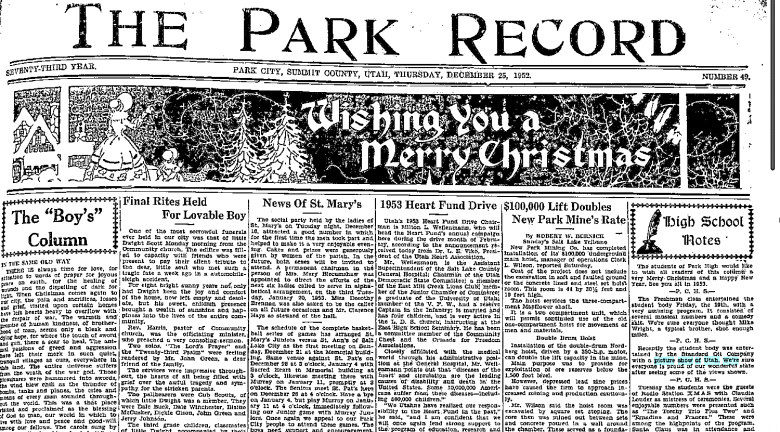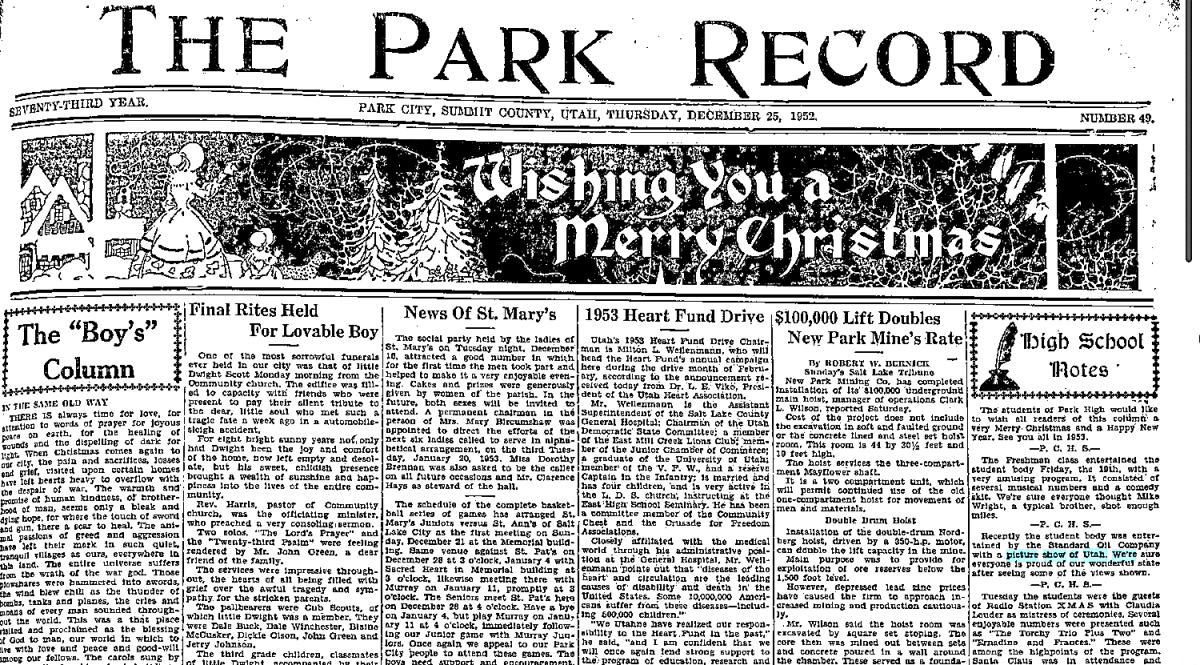
Seventy years ago, Park City was down so low it was hard to see the way up. That seemed especially true in the last week of the year, facing 1953.
America was balanced at that moment between the outgoing presidency of Harry Truman, the haberdasher from Missouri, and the incoming reign of war hero Dwight Eisenhower. The Korean War was raging, with millions of American soldiers deployed. Among them was Jim Santy, Park City High School Class of ’51, now a Marine. And there was Bud Wright’s son Bob; Bud was Park City’s ambassador of skiing before it was a business, leading tours and delivering groceries and mail on 10-foot-long hickory sticks; Bob had gone from Park City High to the University of Utah on a football scholarship before he was sucked into the Korean War.
Still to come was the middle-class expansion of the 1950s and the invention, more or less, of the teenager and the suburbs. Some parts of the country, such as the West Coast, were more optimistic than others, but in Park City it was a time of declining fortunes, especially in its lifeblood mining industry. You might say it had an un-diversified economy. Metal prices kept falling. Mines were shuttered. From 1940 to 1950, the Park City population dropped from 3,739 people to 2,254. Worse was still to come: By 1960, it would plummet to 1,366 people.
The Utah Mining Association, a trade group, was whistling in the dark in 1952. An ad in the Dec. 25 issue of The Park Record from the Mining Association ran with a drawing of a figure in a miner’s hat with a headlamp and the legend, “Miner Mike says …”
Miner Mike said there was a sword of Damocles hanging by a thread above the mining industry. It was the cost “of supplies, of labor and taxes,” “Mike” explained. “If those go too high, the thread breaks — just as it has broken for several Utah mines only recently — and operations stop. When that happens, we’re all hurt.”
Another way of saying this is that the industry wanted to warn Park City laborers, who might seek higher wages for grueling work amid falling metal prices in 1953, that they could imperil the profits of mine owners, their livelihoods and homes, and the remaining mines themselves.
They were tougher times in Park City than we even can see today. But what tugged our heartstrings more was an article on the front page of that issue of The Park Record under the headline “Final Rites Held For Lovable Boy.” You just don’t see headlines like that anymore — and it’s because of the word “lovable.” It sounds as though it came from the scene toward the end of “It’s a Wonderful Life,” when Clarence shows George what Bedford Falls would look like if George had never been born. Park City in 1952 sounds a little like Pottersville and a lot like a community that knew what it was, and it was decent, even as it was crumbling.
“One of the most sorrowful funerals ever held in our city was that of little Dwight Scott Monday morning from the Community church,” the article begins. “The edifice was filled to capacity with friends who were present to pay their silent tribute to the dear, little soul who met such a tragic fate a week ago in an automobile-sleigh accident.”
We had thought we might compare how Parkites looked to 1953 with our prospect on the verge of 2023 — but there wasn’t much to look forward to in that last week of December, 1952, or if there was, we cannot see it from here. Young Dwight Scott’s death in an automobile-sleigh accident, of all things, must have been an arrow through heavy hearts. It also must have felt like a metaphor for a crushing modernity that threatened to leave Park City in the dust.
Tragedy is no stranger to some of us, even now, even here — yet we have so much more to look forward to today. We may struggle with affluence and outside corporations, we may worry about Russia and Ukraine, and climate change, but our lives for the most part are not nasty, brutish and short. And there is so much beauty in this world. One doesn’t cancel the other out. By some twist of contingency and fate, we who are alive are the lucky ones.
So were Jim Santy and Bob Wright, who both made it back alive from Korea after the war, which ended with an armistice in July, 1953. They put down new roots in Park City. The tough times probably didn’t look as hard after Korea. Santy would serve on the Park City Council, first in the 1960s and again in the 1980s and ’90s, and on the School Board, and spend years as the music instructor for Park City schools. Wright was an engineer who commuted to work in Salt Lake City and moonlighted as a ski patroller, at Snow Park resort and, after Snow Park closed, at Park City Mountain.
Both lived long enough to see the business of skiing rescue the city from its past — and the population rebounding, which must have seemed miraculous. Today we have the luxury of worrying about growth; we still don’t have a diversified economy; we have no middle class; and we might well ask who is rebuilding our community.
Those are good questions for 2023.
Happy New Year, Park City.

